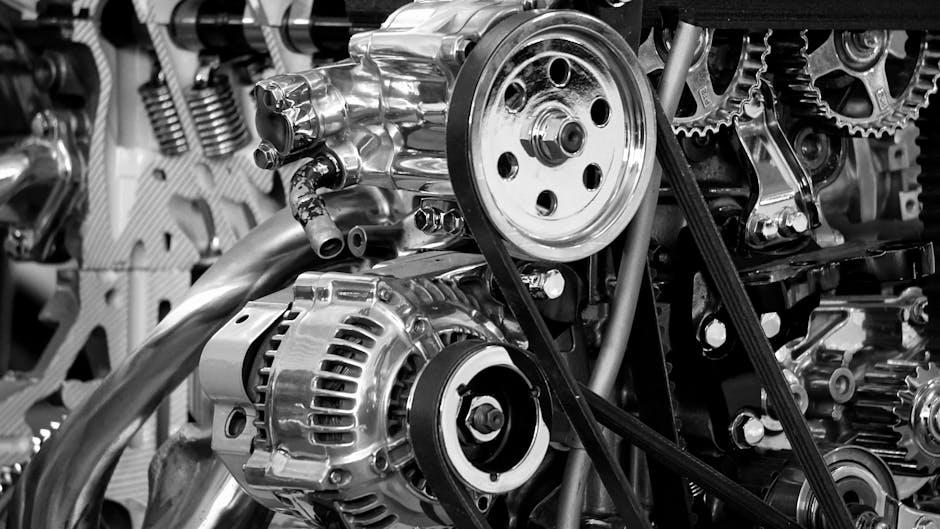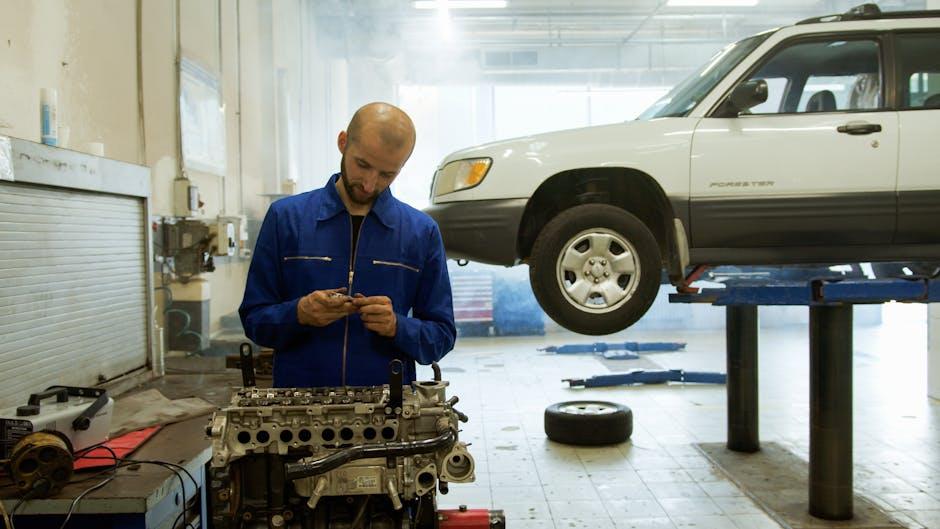Beneath the hum of your engine and the smooth glide of the wheels lies a crucial component that often goes unnoticed until something goes wrong—the transmission. Acting as the vehicle’s middleman, it seamlessly shifts gears, ensuring everything from a gentle cruise to a speedy sprint feels effortless. But like any intricate system, transmissions can develop issues that disrupt this harmony. In this article, we’ll explore some of the most common transmission problems drivers face and the practical fixes that can help get you back on the road with confidence. Whether you’re a seasoned mechanic or just a curious car owner, understanding these issues can save you time, money, and a good deal of frustration.
Table of Contents
- Common Transmission Issues Every Driver Should Know
- Signs Your Transmission Needs Immediate Attention
- Diagnosing Fluid Leaks and Understanding Their Impact
- Effective Solutions for Slipping Gears and Delayed Shifting
- Preventative Maintenance to Extend Transmission Life
- When to Seek Professional Transmission Repair or Replacement
- Q&A
- Concluding Remarks

Common Transmission Issues Every Driver Should Know
One of the most frequent signs that a vehicle’s transmission is struggling is delayed or erratic shifting. This can manifest as hesitation when changing gears or sudden jerks, making your drive less smooth and potentially unsafe. Often, these symptoms point to worn-out clutch plates in manual transmissions or issues with the transmission fluid levels and quality in automatics. Keeping an eye (and ear) out for unusual noises such as whining or grinding can also help drivers catch problems before they escalate.
Another common concern involves fluid leaks beneath the vehicle, which can lead to disastrous overheating and component damage if left unattended. Transmission fluid not only lubricates but also cools the internal parts, so leak repair is critical. Drivers might also experience slipping gears or a burning smell, signaling internal wear or overheating. The simple maintenance tasks like regular fluid checks combined with timely professional inspections can save significant repair costs and prolong transmission life.
| Symptom | Possible Cause | Recommended Action |
|---|---|---|
| Delayed shifting | Low or dirty transmission fluid | Fluid change and filter replacement |
| Grinding noises | Worn clutch or damaged gears | Professional inspection and parts replacement |
| Fluid leak | Damaged seals or gaskets | Seal repair and fluid top-up |

Signs Your Transmission Needs Immediate Attention
When your transmission starts to falter, it rarely waits for a convenient time to announce itself. Watch out for unusual noises like whining, clunking, or buzzing when shifting gears. These sounds can be the first whispers of deeper problems lurking under the hood. Additionally, if your vehicle hesitates, slips between gears, or experiences a delay in acceleration, it’s a clear signal that your transmission is struggling to perform.
Keep an eye on these frequent red flags that often require prompt professional diagnosis and repair:
- Fluid leaks: A reddish fluid pooling under your car can indicate a transmission fluid leak.
- Burning smell: Overheated transmission fluid smells like burnt toast and signals urgent intervention.
- Warning lights: The “Check Engine” or transmission-specific lights illuminate on your dashboard.
- Gear slipping: The transmission unexpectedly shifts out of gear or shifts erratically.
| Symptom | Potential Cause | Urgency Level |
|---|---|---|
| Grinding Noise | Worn Gears or Low Fluid | High |
| Delayed Gear Engagement | Transmission Fluid Issues | Medium |
| Fluid Leaks | Seal or Gasket Failure | High |
| Slip Between Gears | Worn Clutch or Bands | High |

Diagnosing Fluid Leaks and Understanding Their Impact
Spotting fluid leaks early can save your transmission from serious damage. Transmission fluid, usually a vivid red or green, often finds its way onto the ground beneath where you park. Pay close attention to any slippery puddles as well as a burning smell, which can indicate overheating from low fluid levels. Regularly check the fluid reservoir for drops in volume or discoloration, as these are subtle signs of a breach in your system. Using a bright flashlight and inspecting seals, gaskets, and the valve body can help pinpoint the source before the leak worsens.
Understanding how leaks affect your vehicle is crucial for timely intervention. Loss of transmission fluid compromises lubrication and cooling, which leads to increased friction and overheating, accelerating wear on internal components. This often results in:
- Delayed or rough gear shifts
- Transmission slipping
- Complete transmission failure if ignored
| Leak Location | Impact | Recommended Action |
|---|---|---|
| Seals & Gaskets | Minor fluid loss, easy to fix | Seal replacement or gasket reseal |
| Transmission Pan | Moderate leak, potential debris entry | Pan gasket replacement, fluid flush |
| Torque Converter | Severe leak, affects fluid pressure | Component repair or replacement |

Effective Solutions for Slipping Gears and Delayed Shifting
Addressing slipping gears and delayed shifting requires a combination of diagnostics and targeted repairs. Often, the root causes lie within low transmission fluid levels, worn clutch components, or a failing shift solenoid. Ensuring your vehicle’s transmission fluid is at the proper level and free from contaminants can drastically improve shifting performance. Moreover, replacing old or damaged clutch plates and flywheels can restore smooth gear transitions and prevent slippage during acceleration.
For those experiencing persistent issues, electronic components like the shift solenoid and transmission control module should be evaluated. These parts regulate gear changes and, when malfunctioning, may cause delayed response or slipping. Below is a quick reference to common causes and their ideal remedies:
| Issue | Common Cause | Recommended Fix |
|---|---|---|
| Gear Slipping | Low or dirty transmission fluid | Flush and replace transmission fluid |
| Delayed Shifting | Faulty shift solenoid | Replace shift solenoid |
| Gear Slipping | Worn clutch or torque converter | Inspect and repair clutch components |
- Regular transmission maintenance can prevent most slipping and shifting delays.
- Professional diagnostics ensure precise identification of electronic faults.
- Timely repairs protect against costly transmission overhauls.

Preventative Maintenance to Extend Transmission Life
Regularly caring for your transmission is key to avoiding costly repairs down the road. One of the simplest yet most effective ways to do this is by scheduling routine fluid checks and changes. Transmission fluid acts as the lifeblood of your system, lubricating gears and ensuring smooth operation. Over time, this fluid degrades, loses its efficacy, and can harbor contaminants that wear down internal components. A clean, properly topped-up fluid supply helps maintain optimal temperature and pressure, preventing overheating and premature wear.
Implementing a few easy habits can dramatically extend your transmission’s life. Consider these daily practices:
- Monitoring fluid levels: Check monthly to spot leaks or burn signs early.
- Gentle driving: Avoid rapid acceleration and harsh shifting to reduce strain.
- Cooling system upkeep: Ensure the radiator and cooling fan are in good shape to prevent transmission overheating.
| Maintenance Task | Recommended Interval | Benefit |
|---|---|---|
| Transmission Fluid Change | Every 30,000 – 60,000 miles | Preserves fluid quality for smooth shifting |
| Transmission Filter Replacement | Every 50,000 miles or with fluid change | Traps debris to protect internal parts |
| Transmission Flush | As recommended by manufacturer | Removes sediment and old fluid buildup |

When to Seek Professional Transmission Repair or Replacement
Knowing when to take your vehicle to a professional can prevent minor transmission issues from turning into costly repairs. If you notice persistent symptoms such as slipping gears, delayed shifting, unusual noises, or fluid leaks that don’t resolve with basic maintenance, it’s time to seek expert evaluation. Ignoring these signs often leads to further internal damage, which may necessitate a complete transmission replacement rather than a repair.
Consider the following key indicators that demand professional intervention:
- Burning Smell: Overheated transmission fluid can emit a distinctive burnt odor.
- Fluid Discoloration: Transmission fluid that appears dark or contains burnt particles.
- Dashboard Warning Lights: Transmission or check engine lights that illuminate unexpectedly.
- Unresponsive Transmission: Hesitation or failure to engage gears properly.
| Symptom | Possible Outcome | Recommended Action |
|---|---|---|
| Gear Slipping | Increased wear, loss of control | Professional diagnosis and repair |
| Fluid Leak | Low fluid, overheating | Inspect seals and refill fluid |
| Delayed Engagement | Potential internal damage | Immediate professional evaluation |
Q&A
Q&A:
Q1: What are some of the most common transmission problems drivers face?
A1: The usual suspects include slipping gears, delayed or rough shifting, transmission fluid leaks, strange noises like whining or clunking, and overheating. These issues often hint at worn-out components, low fluid levels, or clogged filters.
Q2: How can I tell if my transmission is slipping?
A2: If your car unexpectedly changes gears, loses power when accelerating, or the RPMs jump without corresponding speed increase, your transmission might be slipping. This can feel like a loss of control, so it’s best to get it checked promptly.
Q3: What causes a transmission to overheat, and why is it dangerous?
A3: Overheating typically results from low transmission fluid, heavy towing, or malfunctioning cooling systems. Heat damages the delicate internal parts and fluid, accelerating wear and potentially leading to costly repairs.
Q4: Can I fix minor transmission issues myself?
A4: For minor problems like low or dirty transmission fluid, you can often perform a fluid change or top-off yourself. However, most transmission repairs require specialized knowledge and tools, so seek professional assistance for anything beyond basic maintenance.
Q5: Why is transmission fluid important, and how often should it be changed?
A5: Transmission fluid lubricates and cools the system while enabling smooth gear shifts. Over time, it degrades and loses effectiveness. Most manufacturers recommend changing it every 30,000 to 60,000 miles, but always follow your vehicle’s specific guidelines.
Q6: What are the signs of a transmission fluid leak?
A6: Look for puddles or spots of reddish or brownish fluid under your car, a burning smell, or transmission slipping. Fluid leaks reduce the system’s lubrication, leading to overheating and damage.
Q7: When should I consider a transmission rebuild or replacement?
A7: If your transmission has severe internal damage, persistent slipping, or complete failure, a rebuild or replacement might be the only solution. This is usually after diagnosis by a trusted technician confirms the repair cost outweighs minor fixes.
Q8: How can I prevent common transmission problems?
A8: Regular maintenance is key—check and change fluids on schedule, avoid abrupt gear changes, don’t overload your vehicle, and address any strange noises or behavior immediately. A little care goes a long way in transmission longevity.
Q9: Is it normal for my transmission to make noise?
A9: Some humming or slight whining can be normal, especially in certain gear ranges or during acceleration. However, loud clunks, grinding, or continuous noises often signal trouble that needs prompt inspection.
Q10: Can transmission problems affect fuel efficiency?
A10: Absolutely. A slipping or malfunctioning transmission can cause your engine to work harder, wasting fuel and reducing efficiency. Keeping your transmission healthy contributes to better gas mileage overall.
Concluding Remarks
In the intricate dance of gears and fluids that power your vehicle, the transmission plays a silent yet vital role. Understanding common transmission problems and their fixes not only empowers you to tackle issues head-on but also keeps your ride smooth and reliable for miles to come. Whether it’s a simple fluid change or a more complex repair, staying informed is your best defense against unexpected breakdowns. So, the next time your transmission gives you a sign, you’ll be ready—not just with knowledge, but with the confidence to steer through the challenge and back onto the open road.

